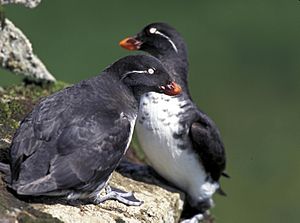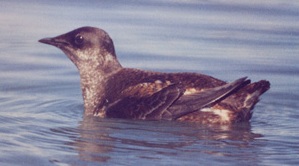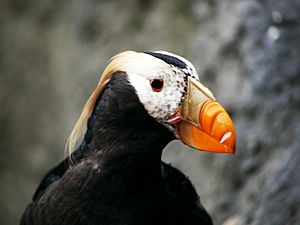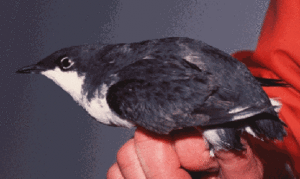Auk facts for kids
Quick facts for kids Auks |
|
|---|---|
 |
|
| Parakeet auklets (Aethia psittacula) | |
| Scientific classification |
|
| Kingdom: | Animalia |
| Phylum: | Chordata |
| Class: | Aves |
| Order: | Charadriiformes |
| Clade: | Pan-Alcidae |
| Family: | Alcidae Leach, 1820 |
| Type species | |
| Alca torda Linnaeus, 1758
|
|
| Subfamilies | |
|
|
An auk or alcid is a type of bird that belongs to the family Alcidae. These birds are part of a larger group called Charadriiformes.
The auk family includes many cool birds like murres, guillemots, auklets, puffins, and murrelets. The name auk comes from the Icelandic word álka, which means "sea-bird."
Most auks can "fly" underwater, using their wings to swim, as well as fly in the air. They are amazing swimmers and divers. However, when they walk on land, they can look a bit clumsy!
Some auks have different names depending on where you are. For example, what Europeans call "guillemots" are known as "murres" in North America. The little auk is also called a "dovekie."
Contents
What Do Auks Look Like?
Auks might remind you of penguins because they often have black and white feathers and stand upright. They also share some habits with penguins. But don't be fooled! Auks and penguins are not closely related. They just look similar because they have both adapted to a similar way of life. This is called convergent evolution.
Male and female auks look very much alike. This is known as being monomorphic.
Auks come in different sizes. The smallest is the least auklet, which is about 15 centimeters (6 inches) tall and weighs around 85 grams (3 ounces). The largest is the thick-billed murre, which can be about 45 centimeters (18 inches) tall and weigh up to 1 kilogram (2.2 pounds).
Because their wings are short, auks have to flap them very fast to fly in the air. Their wings are a compromise. They are designed to be good for diving underwater, but still just good enough for flying in the air.
How They Move
Auks are excellent swimmers and divers. They use their wings to "fly" through the water, much like penguins do. They have given up some flying ability and easy movement on land to be better at swimming.
Some auks, like the Uria guillemots and murrelets, are super efficient underwater. Others, like puffins and auklets, are better at flying and walking.
What Do Auks Eat?
Auks are pursuit divers, meaning they chase their food underwater. They are often compared to penguins in how they hunt.
Auks mostly eat small fish and tiny sea creatures like krill. They dive deep to catch their prey.
- Uria guillemots can dive as deep as 100 meters (330 feet).
- Cepphus guillemots can dive about 40 meters (130 feet).
- Auklets usually dive around 30 meters (100 feet).
Murres are strong swimmers and often hunt fast-moving schooling fish. Auklets, on the other hand, prefer slower-moving krill.
Where Do Auks Live and Breed?
Auks are pelagic birds. This means they spend most of their lives out on the open sea. They only come ashore when it's time to breed and lay eggs. Some species, like the common guillemot, even spend a lot of the year protecting their nesting spot.
Auks usually stay with the same partner for life. They typically lay only one egg each breeding season. They also tend to return to the same nesting spot year after year. This is called being philopatric.
Nesting Habits
Auks have different ways of nesting:
- Some, like the Uria guillemots (murres), build huge colonies on the edges of cliffs.
- Others, like the Cepphus guillemots, nest in smaller groups on rocky coasts.
- Puffins, auklets, and some murrelets dig burrows to make their nests.
Almost all auk species live in colonies, except for the Brachyramphus murrelets.
How Auks Evolved
Scientists used to think auks were a very old and unique group of birds. But newer studies, looking at their DNA, show that auks are actually related to gulls and similar birds. They are part of the Lari group.
Auks changed a lot from their ancestors. They went from being wading shorebirds to diving seabirds. This big change happened because of strong natural selection.
The oldest clear fossils of auks are about 35 million years ago (mya), from the late Eocene period. Most of the types of auks we see today have been around for at least 5 million years.
Fossils found in California and Maryland suggest that auks first evolved in the Pacific Ocean. From there, they slowly spread to other parts of the world.
Where Auks Live Today
Today, auks live in cooler northern waters. They can't easily spread to warmer areas because their hunting method (chasing prey underwater) is less effective in warm water. Small fish, which auks eat, can swim much faster in warmer temperatures.
There are fewer auk species in the Atlantic Ocean (6 species) compared to the Pacific Ocean (19–20 species). This is because many auk species in the Atlantic became extinct a long time ago.
Auks usually stay near continental shelves and don't breed on many oceanic islands.
Types of Auks
|
||||||||||||||||||||||||||||||||||||||||||||||||||||||||||||||||||||||||||||||||||||||||||||||||||||||||||||||||||||||||||||||||||||||||||||||||
| Cladogram of the Alcidae family |
Auks are divided into two main groups:
- The puffins and auklets, which usually have thicker bills.
- The murres, true auks, murrelets, and guillemots, which have more slender bills.
Scientists use DNA studies to understand how these groups are related.
Alcinae Subfamily
This group includes typical auks and murres.
- Uria
- Common murre or common guillemot (Uria aalge)
- Thick-billed murre or Brünnich's guillemot (Uria lomvia)
- Alle
- Little auk or dovekie (Alle alle)
- Pinguinus
- Alca
- Razorbill (Alca torda)

Synthliboramphini Tribe
This group includes synthliboramphine murrelets.
- Synthliboramphus
- Scripps's murrelet (Synthliboramphus scrippsi)
- Guadalupe murrelet (Synthliboramphus hypoleucus)
- Craveri's murrelet (Synthliboramphus craveri)
- Ancient murrelet (Synthliboramphus antiquus)
- Japanese murrelet (Synthliboramphus wumizusume)
Cepphini Tribe
This group includes true guillemots.

- Cepphus
- Black guillemot or tystie (Cepphus grylle)
- Pigeon guillemot (Cepphus columba)
- Kurile guillemot (Cepphus columba snowi)
- Spectacled guillemot (Cepphus carbo)
Brachyramphini Tribe
This group includes brachyramphine murrelets.

- Brachyramphus
- Marbled murrelet (Brachyramphus marmoratus)
- Long-billed murrelet (Brachyramphus perdix)
- Kittlitz's murrelet (Brachyramphus brevirostris)
Fraterculinae Subfamily
This group includes auklets and puffins.
Aethiini Tribe
This group includes auklets.
- Ptychoramphus
- Cassin's auklet (Ptychoramphus aleuticus)
- Aethia
- Parakeet auklet (Aethia psittacula)
- Crested auklet (Aethia cristatella)
- Whiskered auklet (Aethia pygmaea)
- Least auklet (Aethia pusilla)
Fraterculini Tribe
This group includes puffins.

- Cerorhinca
- Rhinoceros auklet (Cerorhinca monocerata)
- Fratercula
- Atlantic puffin (Fratercula arctica)
- Horned puffin (Fratercula corniculata)
- Tufted puffin (Fratercula cirrhata)
See also
 In Spanish: Álcidos para niños
In Spanish: Álcidos para niños



